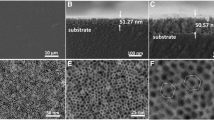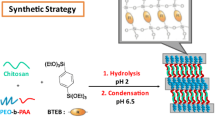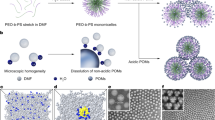Abstract
Volatile organic solvents were considered to have little influence on the synthesis of mesostructured materials through evaporation-induced self-assembly (EISA), because upon evaporation they leave the sol and hence do not interfere with the self-assembly process. We show here that the choice of solvent is crucial in the synthesis of thin films of phenylene-bridged periodic mesoporous organosilica (benzene PMO). Methanol is found to be a better solvent for the synthesis of thin films, whereas ethanol favors the formation of (HO)3Si-C6H4-Si(OH)3 crystals, the identity and structure of which is established by X-ray diffraction. A ternary reactant composition diagram is designed to visualize the relationship among multiple synthesis experiments and to guide the interpretation of experimental results and optimization of the quality of the periodic mesoporous organosilica film. Our study highlights the importance of solvent choice, a factor often neglected in EISA. We expect it to inspire researchers to explore the effect of solvent in designing the synthesis of mesoporous materials.
Similar content being viewed by others

References
Kresge CT, Leonowicz ME, Roth WJ, Vartuli JC, Beck JS. Ordered mesoporous molecular sieves synthesized by a liquid-crystal template mechanism. Nature, 1992, 359(6397): 710–712
Beck JS, Vartuli JC, Roth WJ, Leonowicz ME, Kresge CT, Schmitt KD, Chu CTW, Olson DH, Sheppard EW, McCullen SB, Higgins JB, Schlenker JL. A new family of mesoporous molecular sieves prepared with liquid crystal templates. J Am Chem Soc, 1992, 114(27): 10834–10843
Yang H, Kuperman A, Coombs N, Mamiche-Afara S, Ozin GA. Synthesis of oriented films of mesoporous silica on mica. Nature, 1996, 379(6567): 703–705
Aksay IA, Trau M, Manne S, Honma I, Yao N, Zhou L, Fenter P, Eisenberger PM, Gruner SM. Biomimetic pathways for assembling inorganic thin films. Science, 1996, 273(5277): 892–898
Yang H, Coombs N, Sokolov I, Ozin GA. Free-standing and oriented mesoporous silica films grown at the air-water interface. Nature, 1996, 381(6583): 589–592
Lu Y, Ganguli R, Drewien CA, Anderson MT, Brinker CJ, Gong W, Guo Y, Soyez H, Dunn B, Huang MH, Zink JI. Continuous formation of supported cubic and hexagonal mesoporous films by sol-gel dip-coating. Nature, 1997, 389: 364–368
Brinker CJ, Lu Y, Sellinger A, Fan H. Evaporation-induced self-assembly: Nanostructures made easy. Adv Mater, 1999, 11: 579–585
Lu Y, Fan H, Stump A, Ward TL, Rieker T, Brinker CJ, Aerosol-assisted self-assembly of mesostructured spherical nanoparticles. Nature, 1999, 398: 223–226
Grosso FC, de AA Soler-Illia GJ, Crepaldi EL, Amenitsch H, Brunet-Bruneau A, Bourgeois A, Sanchez C, Fundamentals of mesostructuring through evaporation-induced self-assembly. Adv Funct Mater, 2004, 14: 309–322
Doshi DA, Huesing NK, Lu M, Fan H, Lu Y, Simmons-Potter K, Potter BG, Hurd AJ, Brinker CJ. Optically defined multifunctional patterning of photosensitive thin-film silica mesophases. Science, 2000, 290: 107–111
Fan H, Lu Y, Stump A, Reed ST, Baer T, Schunk R, Perez-Luna V, Lopez GP, Brinker CJ. Rapid prototyping of patterned functional nanostructures. Nature, 2000, 405: 56–60
Yang P, Wirnsberger G, Huang HC, Cordero SR, McGehee MD, Scott B, Deng T, Whitesides GM, Chmelka BF, Buratto SK, Stucky GD. Mirrorless lasing from mesostructured waveguides patterned by soft lithography. Science, 2000, 287: 465–467
Hatton BD, Landskron K, Whitnall W, Perovic DD, Ozin GA. Spin-coated periodic mesoporous organosilica thin films — Towards a new generation of low-dielectric-constant materials. Adv Funct Mater, 2005, 15: 823–829
Landskron K, Hatton BD, Perovic DD, Ozin GA. Periodic mesoporous organosilicas containing interconnected [Si(CH2)]3 rings. Science, 2003, 302: 266–269
Wang W, Grozea D, Kim A, Perovic DD, Ozin GA. Vacuum-assisted aerosol deposition of a low-dielectric-constant periodic mesoporous organosilica film. Adv Mater, 2010, 22: 99–102
Wang WD, Grozea D, Kohli S, Perovic DD, Ozin GA. Water repellent periodic mesoporous organosilicas. ACS Nano, 2011, 5: 1267–1275
Grosso D, Babonneau F, Albouy PA, Amenitsch H, Balkenende AR, Brunet-Bruneau A, Rivory J. An in situ study of mesostructured CTAB—silica film formation during dip coating using time-resolved SAXS and interferometry measurements. Chem Mater, 2002, 14: 931–939
Besson S, Gacoin T, Ricolleau C, Jacquiod C, Boilot JP. Phase diagram for mesoporous CTAB-silica films prepared under dynamic conditions. J Mater Chem, 2003, 13: 404–409
Gibaud A, Grosso D, Smarsly B, Baptiste A, Bardeau JF, Babonneau F, Doshi DA, Chen Z, Brinker CJ, Sanchez C. Evaporation-controlled self-assembly of silica surfactant mesophases. J. Physl Chem B, 2003, 107: 6114–6118
Cagnol F, Grosso D, Soler-Illia GJdAA, Crepaldi EL, Babonneau F, Amenitsch H, Sanchez C. Humidity-controlled mesostructuration in CTAB-templated silica thin film processing. The existence of a modulable steady state. J Mater Chem, 2003, 13: 61–66
Innocenzi P, Falcaro P, Grosso D, Babonneau F. Order—disorder transitions and evolution of silica structure in self-assembled mesostructured silica films studied through FTIR spectroscopy. J Phys Chem B, 2003, 107: 4711–4717
Inagaki S, Guan S, Fukushima Y, Ohsuna T, Terasaki O. Novel mesoporous materials with a uniform distribution of organic groups and inorganic oxide in their frameworks. J Am Chem Soc, 1999, 121: 9611–9614
Melde BJ, Holland BT, Blanford CF, Stein A. Mesoporous sieves with unified hybrid inorganic/organic frameworks. Chem Mater, 1999, 11: 3302–3308
Asefa T, MacLachlan MJ, Coombs N, Ozin GA. Periodic mesoporous organosilicas with organic groups inside the channel walls. Nature, 1999, 402: 867–871
Fujita S, Inagaki S. Self-organization of organosilica solids with molecular-scale and mesoscale periodicities. Chem Mater, 2008, 20: 891–908
Goto Y, Mizoshita N, Ohtani O, Okada T, Shimada T, Tani T, Inagaki S. Synthesis of mesoporous aromatic silica thin films and their optical properties. Chem Mater, 2008, 20: 4495–4498
Mizoshita N, Ikai M, Tani T, Inagaki S. Hole-transporting periodic mesostructured organosilica. J Am Chem Soc, 2009, 131: 14225–14227
Inagaki S, Ohtani O, Goto Y, Okamoto K, Ikai M, Yamanaka KI, Tani T, Okada T. Light harvesting by a periodic mesoporous organosilica chromophore. Angew Chem Int Ed, 2009, 48: 4042–4046
Takeda H, Goto Y, Maegawa Y, Ohsuna T, Tani T, Matsumoto K, Shimada T, Inagaki S. Visible-light-harvesting periodic mesoporous organosilica. Chem Commun, 2009: 6032–6034
Cerveau G, Corriu RJP, Dabiens B, Le Bideau J. Synthesis of stable organo(bis-silanetriols): X-ray powder structure of 1,4-bis (trihydr-oxysilyl)benzene. Angew Chem Int Ed, 2000, 39: 4533–4537
Author information
Authors and Affiliations
Corresponding author
Additional information
OZIN Geoffrey A. studied at King’s College London and Oriel College Oxford University, before completing an ICI Postdoctoral Fellowship at Southampton University. Currently he is the Tier 1 Canada Research Chair in Materials Chemistry, Distinguished University Professor at the University of Toronto, and a Founding Fellow of the Nanoscience Team at the Canadian Institute for Advanced Research. Internationally he is or has served as an Honorary Professor at The Royal Institution Great Britain and University College London, External Advisor for the London Centre for Nanotechnology, Alexander von Humboldt Senor Scientist at the Max Planck Institute for Surface and Colloid Science Potsdam, and Distinguished Research Fellow at Karlsruhe Institute of Technology. Over a four decade career he has made important scientific and technological advances in Nanochemistry, which have help shape the course of Nanotechnology. He has made benchmark discoveries in the fields of Nanomaterials, Nanoporous Materials, Photonic Crystals and Nanomachines.
WANG WenDong obtained his B.Sc. in chemistry from Kuang Yaming Honors School in 2006 at Nanjing University, where he studied self-assembly of alumina nanotube with Professor DING WeiPing. His PhD work with Professor OZIN Geoffrey focuses on the application of periodic mesoporous organosilica as low-dielectric-constant materials in microprocessors. He is currently a post-doctoral fellow in Professor AIZENBERG Joanna’s group at Wyss Institute for Biologically Inspired Engineering at Harvard. His research interests include mesoporous materials, photonics, graphene, self-assembly, energy, cleantech and the commercialization of technology.
FAULKNER Daniel received his MA and MSci degrees in natural sciences from the University of Cambridge in 2008, specialising in chemistry. During his final year he researched enantioselective heterogeneous hydrogenation reactions under professor Richard Lambert. He is now pursuing a PhD at the University of Toronto in the departments of materials science & engineering and chemistry under the supervision of professors KHERANI Nazir, OZIN Geoffrey and PEROVIC Doug. His research focus is the synthesis and characterization of NaYF4-based upconverting materials and their potential application to high efficiency solar cells.
MOIR Jonathon obtained his Bachelor of Science (Honours) in Chemistry at Queen’s University in Kingston, Ontario, Canada under the supervision of Dr. Cathleen Crudden. He has done research at multiple universities and for two government departments, working on projects ranging from organic synthesis to catalysis and degradation of pollutants in fuel emissions. Currently, Jonathon is studying to obtain his Masters of Science at the University of Toronto, under the direction of Dr. OZIN Geoffrey. His research focuses primarily on the synthesis and application of nanoparticles and nanomaterials to various catalytic reactions.
Electronic supplementary material
Rights and permissions
About this article
Cite this article
Wang, W., Faulkner, D., Moir, J. et al. The effect of solvent in evaporation-induced self-assembly: A case study of benzene periodic mesoporous organosilica. Sci. China Chem. 54, 1920–1925 (2011). https://doi.org/10.1007/s11426-011-4457-x
Received:
Accepted:
Published:
Issue Date:
DOI: https://doi.org/10.1007/s11426-011-4457-x



